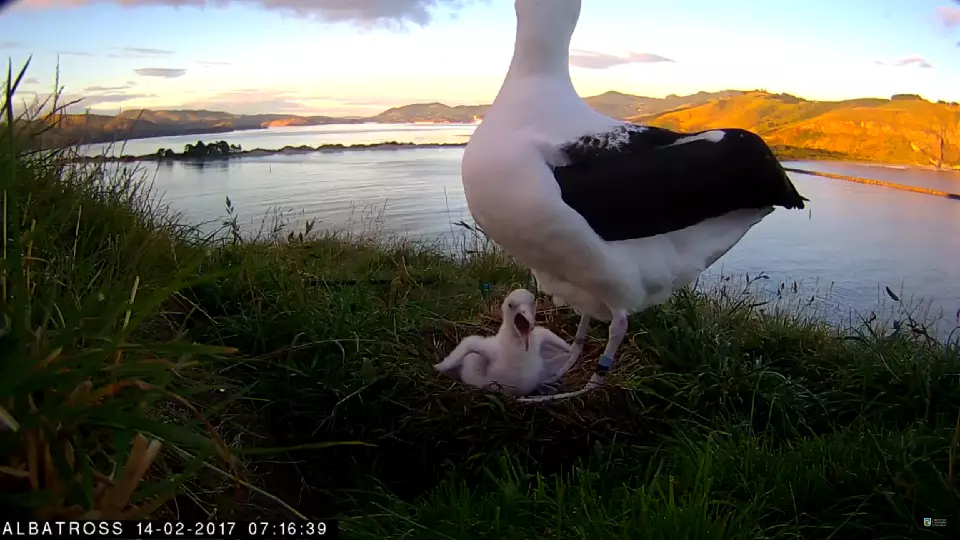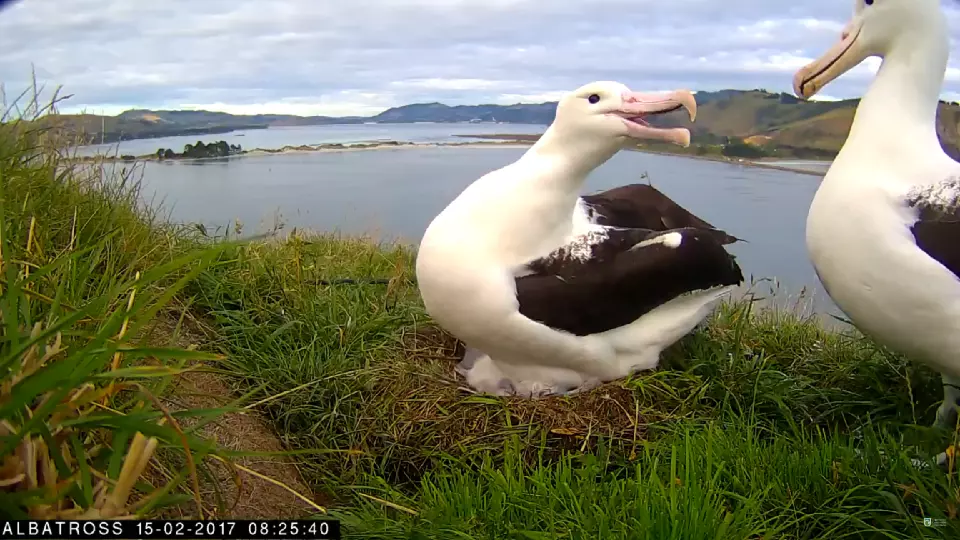Paldies, roosaluristajaroosaluristaja wrote:Iespējams arī ka nogalina. Sermuļi un zebiekstes Jaunzēlandē nav vietējās faunas pārstāvji, tās ir invazīvas svešzemju sugas tāpat kā, teiksim, žurkas vai kaķi dažādās okeānu salās, truši Austrālijā, mangusti Karību jūras salās, latvāņi un Amerikas ūdeles Latvijā utt. Varbūt šajā gadījumā tiek pielietota kāda cita metode, bet no dabas aizsardzības viedokļa šiem dzīvniekiem tajās salās nav jābūt un dabiski viņi tur nemaz nespētu nokļūt, tikai ar cilvēka palidzību. Ja viņi kaitē vietējās faunas pārstāvjiem, īpaši tos saudzēt nav nekāda pamatojuma.Vērotāja wrote:Labrīt
La Marie, liels paldies par informāciju no projekta lapas
Īsti nesapratu par tiem sīkajiem plēsējiem. Viņi taču negalina tos nost, vai ne? (ja apkalpo dabas draugu organizācijas)
Ja nenogalina, tad ko dara? Aizved? Bet vai viņiem šajā apvidū nepaliek ģimene?
Ziemeļu karaliskais albatross, Jaunzēlande, 2016/2017
Re: Ziemeļu karaliskais albatross, Jaunzēlande, 2017
Dabu vajag mīlēt ar sirdi, bet izprast to vajag ar prātu. U.Piterāns
- Lianaliesma
- Posts: 48277
- Joined: 02 Jun 2013 16:41
Re: Ziemeļu karaliskais albatross, Jaunzēlande, 2017
2016.gadā kaut ko tādu viņi ir apstiprinājuši... plaša mēroga plēsoņu izskaušanas programmu...Vērotāja wrote:Paldies, roosaluristajaroosaluristaja wrote:Iespējams arī ka nogalina. Sermuļi un zebiekstes Jaunzēlandē nav vietējās faunas pārstāvji, tās ir invazīvas svešzemju sugas tāpat kā, teiksim, žurkas vai kaķi dažādās okeānu salās, truši Austrālijā, mangusti Karību jūras salās, latvāņi un Amerikas ūdeles Latvijā utt. Varbūt šajā gadījumā tiek pielietota kāda cita metode, bet no dabas aizsardzības viedokļa šiem dzīvniekiem tajās salās nav jābūt un dabiski viņi tur nemaz nespētu nokļūt, tikai ar cilvēka palidzību. Ja viņi kaitē vietējās faunas pārstāvjiem, īpaši tos saudzēt nav nekāda pamatojuma.Vērotāja wrote:Labrīt
La Marie, liels paldies par informāciju no projekta lapas
Īsti nesapratu par tiem sīkajiem plēsējiem. Viņi taču negalina tos nost, vai ne? (ja apkalpo dabas draugu organizācijas)
Ja nenogalina, tad ko dara? Aizved? Bet vai viņiem šajā apvidū nepaliek ģimene?Pag, bet vai Jaunzēlande nebija tā, kur ir programma visu invazīvo sugu iznīcināšanai?
"Jaunzēlandes unikālās savvaļas dzīvā daba un augi ir mūsu nacionālās identitātes rādītāji. Tie attīstījušies miljoniem gadu bez zīdītāju klātbūtnes, kā rezultātā ir ārkārtīgi neaizsargāti pret ieviestajiem plēsoņām, kas nogalina aptuveni 25000000 iedzimto putnu katru gadu, "Ms Barry saka.
http://www.doc.govt.nz/news/media-relea ... am-effort/
Date: 25 July 2016
Source: Office of the Minister of Conservation
The Government today announced the adoption of the Predator Free New Zealand 2050 target and plans to set up a new public-private partnership company by the beginning of 2017 to help fund regional large-scale predator eradication programmes.
“New Zealand’s unique native creatures and plants are central to our national identity. They evolved for millions of years in a world without mammals and as a result are extremely vulnerable to introduced predators, which kill around 25 million native birds every year,” Ms Barry says.
Kad acis, ausis un sirds atveras, dvēsele izpeldas skaistumā. Z.Mauriņa
Saskaņu forumā veicina savlaicīga un publiska vienošanās par pieņemamāko problēmas risinājumu.
Mēs mācāmies bez nosacījuma iemīlēt ne tikai putnus, bet arī cilvēkus.
Saskaņu forumā veicina savlaicīga un publiska vienošanās par pieņemamāko problēmas risinājumu.
Mēs mācāmies bez nosacījuma iemīlēt ne tikai putnus, bet arī cilvēkus.
Re: Ziemeļu karaliskais albatross, Jaunzēlande, 2017
Nogalina 25 miljonus putnu? Tas ir ļoti daudz.
Dabu vajag mīlēt ar sirdi, bet izprast to vajag ar prātu. U.Piterāns
Re: Ziemeļu karaliskais albatross, Jaunzēlande, 2017
Par putniem nezinu, bet vienu no mazajiem plēsoņām redzēju noķertu projekta lapā - bija bilde kaut kad agrāk. Dzīvnieks neizskatījās dzīvs vairs... kaut nobildēts bija tā neuzkrītoši, ne tā kā tā medniece Latvijā, kura lūšu mammu nošāva. Es tagad to bildi vairs nevaru atrast.
- Lianaliesma
- Posts: 48277
- Joined: 02 Jun 2013 16:41
Re: Ziemeļu karaliskais albatross, Jaunzēlande, 2017
Lieto lamatas un arī indi...
http://www.doc.govt.nz/nature/pests-and-threats/
1080 (nātrija fluoroacetate) ir inde, ko piejauc ēsmai un izmanto, lai kontrolētu virkni plēsējdzīvnieku, īpaši oposumus, žurkas un sermuļus, kas ēd saindētas žurkas.
Te ir tie kukaiņi/dzīvnieki, kas tiek uzskatīti par vietējās faunas apdraudējumiem.
To turēšanai mājdzīvnieku statusā ir ierobežojumi.
Mjā... tā nu tas ir...
Lai arī jūs mīlat, rūpējaties un apmācāt savu mīluli, vairums no tiem saglabā dabas dotos medību instinktus. Jūs nekad nevarat zināt, kādu kaitējumu tie var nodarīt.
http://www.doc.govt.nz/nature/pests-and-threats/
1080 (nātrija fluoroacetate) ir inde, ko piejauc ēsmai un izmanto, lai kontrolētu virkni plēsējdzīvnieku, īpaši oposumus, žurkas un sermuļus, kas ēd saindētas žurkas.
http://www.doc.govt.nz/nature/pests-and ... -a-z/pets/1080 (sodium fluoroacetate) is a poison that is mixed into baits and used to control a range of pests, especially possums, rats and the stoats which eat the poisoned rats.
Te ir tie kukaiņi/dzīvnieki, kas tiek uzskatīti par vietējās faunas apdraudējumiem.
To turēšanai mājdzīvnieku statusā ir ierobežojumi.
Mjā... tā nu tas ir...
Lai arī jūs mīlat, rūpējaties un apmācāt savu mīluli, vairums no tiem saglabā dabas dotos medību instinktus. Jūs nekad nevarat zināt, kādu kaitējumu tie var nodarīt.
However much you love, care for and train your pet most retain natural instincts to hunt. You may never know the damage they cause.
Kad acis, ausis un sirds atveras, dvēsele izpeldas skaistumā. Z.Mauriņa
Saskaņu forumā veicina savlaicīga un publiska vienošanās par pieņemamāko problēmas risinājumu.
Mēs mācāmies bez nosacījuma iemīlēt ne tikai putnus, bet arī cilvēkus.
Saskaņu forumā veicina savlaicīga un publiska vienošanās par pieņemamāko problēmas risinājumu.
Mēs mācāmies bez nosacījuma iemīlēt ne tikai putnus, bet arī cilvēkus.
Re: Ziemeļu karaliskais albatross, Jaunzēlande, 2017
Nevarētu apgalvot, ka tas, ko dara Jaunzēlandē, man šķiet normāli 
Dabu vajag mīlēt ar sirdi, bet izprast to vajag ar prātu. U.Piterāns
- Lianaliesma
- Posts: 48277
- Joined: 02 Jun 2013 16:41
Re: Ziemeļu karaliskais albatross, Jaunzēlande, 2017
Tomēr pašiem albatrosiem vai pingvīniem (un citiem uz zemes ligzdojošajiem putniem) nav dabas izstrādātu cīņas metožu bērnu aizsargāšanai no šiem ieceļojušajiem dzīvnieciņiem...Vērotāja wrote:Nevarētu apgalvot, ka tas, ko dara Jaunzēlandē, man šķiet normāli
Kad acis, ausis un sirds atveras, dvēsele izpeldas skaistumā. Z.Mauriņa
Saskaņu forumā veicina savlaicīga un publiska vienošanās par pieņemamāko problēmas risinājumu.
Mēs mācāmies bez nosacījuma iemīlēt ne tikai putnus, bet arī cilvēkus.
Saskaņu forumā veicina savlaicīga un publiska vienošanās par pieņemamāko problēmas risinājumu.
Mēs mācāmies bez nosacījuma iemīlēt ne tikai putnus, bet arī cilvēkus.
- Lianaliesma
- Posts: 48277
- Joined: 02 Jun 2013 16:41
Re: Ziemeļu karaliskais albatross, Jaunzēlande, 2017
Kad acis, ausis un sirds atveras, dvēsele izpeldas skaistumā. Z.Mauriņa
Saskaņu forumā veicina savlaicīga un publiska vienošanās par pieņemamāko problēmas risinājumu.
Mēs mācāmies bez nosacījuma iemīlēt ne tikai putnus, bet arī cilvēkus.
Saskaņu forumā veicina savlaicīga un publiska vienošanās par pieņemamāko problēmas risinājumu.
Mēs mācāmies bez nosacījuma iemīlēt ne tikai putnus, bet arī cilvēkus.
- Lianaliesma
- Posts: 48277
- Joined: 02 Jun 2013 16:41
Re: Ziemeļu karaliskais albatross, Jaunzēlande, 2017
Kad acis, ausis un sirds atveras, dvēsele izpeldas skaistumā. Z.Mauriņa
Saskaņu forumā veicina savlaicīga un publiska vienošanās par pieņemamāko problēmas risinājumu.
Mēs mācāmies bez nosacījuma iemīlēt ne tikai putnus, bet arī cilvēkus.
Saskaņu forumā veicina savlaicīga un publiska vienošanās par pieņemamāko problēmas risinājumu.
Mēs mācāmies bez nosacījuma iemīlēt ne tikai putnus, bet arī cilvēkus.
- Lianaliesma
- Posts: 48277
- Joined: 02 Jun 2013 16:41
Re: Ziemeļu karaliskais albatross, Jaunzēlande, 2017
Kolonijas jaunumi
Tiešraides ligzdas mazulis tagad sver 1,2 kg
Sakarā ar kontroles programmu pār plēsējiem albatrosu kolonijā...
Fotoattēlā redzami svētdien noķerti sermulis/tēviņš un zebiekste/mātīte. Izskatās līdzīgi, lai arī atšķirīgi lielumā, bet sermulim astesgals ir tumšs.
Kaut zebiekstes ir diezgan izplatītas dažās citās valsts daļās, Otago pussalā tās ir reti, programmas ietvaros notvertas mazāk nekā 10 zebiekstes 50 gadu periodā.
Plēsēju kontrole nav patīkama programmas darba sastāvdaļa, diemžēl nepieciešama, lai nodrošinātu jūras putnu kolonijas dzīvi. Reizēm gandrīz 10 000 jūras putnus ligzdo Toroa ragā pa vasaru un visi ir neaizsargāti pret šiem plēsējiem.

Tiešraides ligzdas mazulis tagad sver 1,2 kg
Sakarā ar kontroles programmu pār plēsējiem albatrosu kolonijā...
Fotoattēlā redzami svētdien noķerti sermulis/tēviņš un zebiekste/mātīte. Izskatās līdzīgi, lai arī atšķirīgi lielumā, bet sermulim astesgals ir tumšs.
Kaut zebiekstes ir diezgan izplatītas dažās citās valsts daļās, Otago pussalā tās ir reti, programmas ietvaros notvertas mazāk nekā 10 zebiekstes 50 gadu periodā.
Plēsēju kontrole nav patīkama programmas darba sastāvdaļa, diemžēl nepieciešama, lai nodrošinātu jūras putnu kolonijas dzīvi. Reizēm gandrīz 10 000 jūras putnus ligzdo Toroa ragā pa vasaru un visi ir neaizsargāti pret šiem plēsējiem.
COLONY UPDATE
Toroa and KGO's chick will hopefully get its first feed sometime this morning at the foster nest. It is hungry and begging but still needs a little more strength in its neck to hold its head up.
Web cam chick weighed 1.2kgs this morning with the older chicks now around 2kgs.
The attached photo is of the introduced predators Sharyn caught on Sunday. The top one is a stoat, these are larger than weasels (below) but smaller than ferrets (not pictured) and have a couple of identification marks that differ from the similar looking weasel. A) Black tip to the tail and B) nice tidy lines where the brown meets the white on side of the belly.
The weasel is somewhat smaller than a stoat (although here in this photo we have a male stoat which is a little bigger than a female stoat and the weasel is a female), no black tip to the tail and has brown patches on the sides of the white belly.
While weasels are fairly common in some other parts of the country, they seems uncommon on the Otago Peninsula and we have caught less than 10 here in the 50 years of the Pukekura/Taiaroa Head daily predator control programme. It is possibly that their small numbers is due to being either out competed or predated by the larger predators (stoats, ferrets or cats).
Predator control isn't a nice part of the job but it is unfortunately necessary to ensure a thriving seabird colony (At times there are nearly 10 000 seabirds on or near the headland over summer and all are vulnerable to predation by introduced predators).

Kad acis, ausis un sirds atveras, dvēsele izpeldas skaistumā. Z.Mauriņa
Saskaņu forumā veicina savlaicīga un publiska vienošanās par pieņemamāko problēmas risinājumu.
Mēs mācāmies bez nosacījuma iemīlēt ne tikai putnus, bet arī cilvēkus.
Saskaņu forumā veicina savlaicīga un publiska vienošanās par pieņemamāko problēmas risinājumu.
Mēs mācāmies bez nosacījuma iemīlēt ne tikai putnus, bet arī cilvēkus.
Re: Ziemeļu karaliskais albatross, Jaunzēlande, 2017
lianaliesma wrote:Kolonijas jaunumi
Tiešraides ligzdas mazulis tagad sver 1,2 kg
Paldies,lianaliesma,par info
Nu nav tur citu iespēju,lai pasargātu putnus.





















